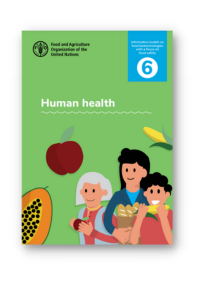Information toolkit on food biotechnologies with a focus on food safety
01/12/2021
.png?sfvrsn=3eb7477_1)
The present FAO Information toolkit on food biotechnologies with a focus on food safety serves as a basis to assist countries in addressing the general public’s concerns on food biotechnology and food safety, to support them in raising awareness of the science of food biotechnologies and food safety and to inform discussions and decisions. It consists of one handbook providing an instruction manual for the whole set of documents and ten booklets, referred to as tools, and which cover background information, general information on the scientific aspects of food biotechnologies and food safety, the rationale behind the claimed benefits of genetically modified (GM) foods, GM food safety assessments and regulations. The tools also touch upon aspects related to human health and the environment, the practical uses and applications, the recent developments and innovations, possibilities to engage with the public.

Handbook - using the information toolkit

Tool 1: Background and guidance
Tool 1 provides general information regarding the background and guidance on food biotechnologies, the safety assessment of foods derived from biotechnologies, and international documents and tools. It contains example materials on what is meant by food biotechnologies. The principles and guidelines developed through the Codex Alimentarius (FAO and WHO, 2020) are introduced as well as the FAO GM Foods Platform , an international database where Codex Members can share data and information on the safety assessment of genetically modified (GM) foods. A list of publications is available in the References section that could be used to develop further understanding of the internationally recognized frameworks related to the safety assessment of foods derived from biotechnologies.

Tool 2 provides some fundamental information on food biotechnologies by addressing some frequently asked questions and providing examples. This tool aims to help defining technical terms, which may differ from one country to another, such as genetically modified organism (GMO), living modified organism (LMO) and genetically engineered organism (GEO).

Tool 3: Rationale for potential benefits
Tool 3 provides information and examples about the rationale for using food biotechnologies. During the global community meeting on the FAO GM Foods Platform, many participants expressed a strong need for support when informing their population about the added value and the reasons of some countries to adopt food biotechnologies. Information on this topic was found to be covered in a limited amount by existing communication materials, in particular those produced by governmental agencies.

Tool 4: GM food safety assessment
Tool 4 provides information and examples on the safety assessment for genetically modified (GM) foods. Analysis and experts’ consultations found this to be a key topic that could provide information and assistance for authorities to communicate around food biotechnologies.

Tool 5 provides general information and examples to deal with regulatory frameworks around food biotechnologies. The examples aim to help users of this toolkit to explain how, why and by whom food biotechnologies are regulated, as well as the purpose of labelling.

Tool 6 provides general information and examples that could help address some concerns that are frequently raised on the safety of foods derived from biotechnologies – namely whether genetically modified (GM) foods in particular, are safe to eat. This topic, along with the topic of GM foods and the environment (the topic of Tool 7), was indicated in an expert consultation as a primary concern of the general public regarding food biotechnologies. This tool can be used in conjunction with Tool 4 on GM food safety assessment.

Tool 7 provides general information and examples on the environmental aspects of growing genetically modified (GM) foods. Environment and human health (the topic of Tool 6) were indicated by the experts as topics of primary concern among the general public in relation to food biotechnologies, and particularly GMOs. The information and the example materials provided here could support information about how environmental safety assurance is performed, or information about the prevention of and response to the accidental release of unauthorized GMOs. The examples include commonly asked questions about the possibility of creating new life forms as a result of growing GMOs, the possible spread of the GMOs grown in the environment, and the specificity of some pest-resistant GMOs.

Tool 8: Practical uses and applications
Tool 8 provides general information and examples of how the genetically modified (GM) foods have been applied, marketed and cultivated in the different areas. It also supports users of the toolkit to showcase concrete examples of the specific characteristics and traits of genetically modified organisms (GMO) such as the pesticide tolerance introduced in a tomato that is being grown in the country.

Tool 9 provides general information and examples on the latest developments, uses and applications in the area of food biotechnology, and it focuses on genome (or gene) editing. It also provides examples that could help users of this toolkit to explain genome editing, the difference between genetic modification and genome editing and the potential benefits of these new technologies. In addition, it supports users to highlight possible research and development activities ongoing in their own country.

Tool 10 provides general information and examples that could help the users of this toolkit to engage with people during the authorization process of genetically modified (GM) foods and when establishing and modifying the national legislation for food biotechnologies in general.
Working towards SDGs:
![]()
![]()
